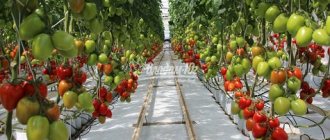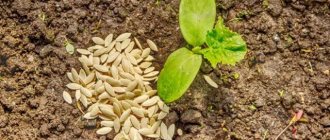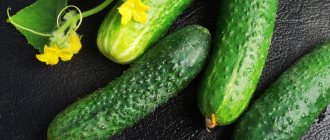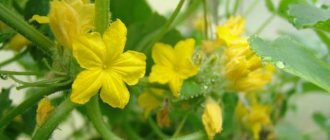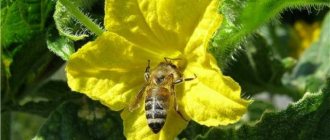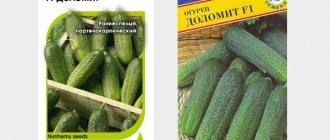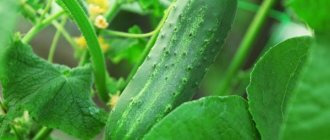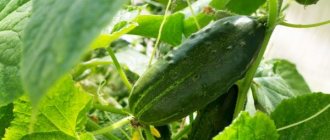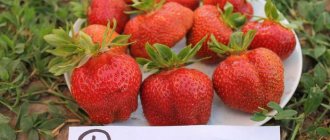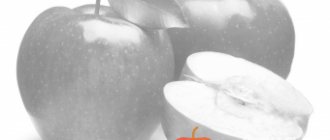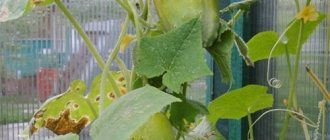When growing cucumbers in greenhouses, it is important to choose the right variety. The good-quality hybrid Red Mullet F1 is recognized as productive, unpretentious and disease-resistant. It has many advantages, including high marketability, wonderful taste, and transportable qualities.
| Landing location | Ripening time | Mode of application | Fruit length | Group | Fruit smoothness | Pollination method |
| Greenhouse | Early ripening (35-45 days) | Universal | Medium - from 10 to 15 cm | Hybrid | Highly lumpy | Parthenocarpic |
Characteristics of red mullet F1 cucumbers
Barabulka cucumber is an early fruiting hybrid from Russian agro. The variety was tested and in 2007 included in the State Register of the Russian Federation and recommended for planting in the Northern, Northwestern, Central regions, the Volga region and the North Caucasus.
Varabulka F1 variety is classified as parthenocarpic. Pollination of crop flowers occurs without the participation of insects. Parthenocarpics bear small, even fruits that do not turn yellow and are stored and transported for a long time.
The plant is indeterminate and branches well. Its flowers are female. The leaves are green and medium in size. 8-12 ovaries are formed in the leaf axil. Most of the fruits are located near the central shoot.
According to the description, reviews and photos, the fruits of the Red Mullet cucumbers have a number of features:
- cylindrical shape;
- large tubercles;
- length 10 - 12 cm;
- weight 90 - 100 g;
- dark green color;
- light stripes;
- white thorns;
- short neck.
Varabulka F1 variety is intended for protected soil. It is grown in private farms, greenhouses and greenhouses.
Advantages and disadvantages
The advantages of this variety include:
- excellent taste and compact size of the fruit (convenient for pickling);
- early ripeness;
- high productivity;
- long fruiting period;
- resistance to diseases and weather changes;
- ability to self-pollinate.
The variety has no obvious disadvantages. But you need to take into account that the seeds of the Red Mullet, like any f1 hybrid, do not have the qualities of the initial variety - completely different cucumbers can grow from them.
Cucumbers with the unusual name “Mullet f1” are characterized by resistance to cladosporiosis, cucumber mosaic virus and powdery mildew. The advantages of the variety are also the following qualities:
- wonderful taste of fruits;
- precociousness;
- good germination;
- disease resistance;
- universal use;
- high productivity;
- friendly harvest formation;
- uniformity and marketability of fruits.
The main positive qualities of “Barabulka” are:
- Self-pollinating abilities;
- Excellent taste characteristics;
- Immunity to diseases;
- High yield;
- Good germination;
- Early ripening;
- Long period of fruiting;
- No tendency to outgrow;
- Commercial appearance;
- Shade tolerance;
Gardeners did not identify any particular shortcomings.
- Frost resistance;
- Resistance to mechanical damage.
The main advantages of this type include the following characteristics:
- versatility in application;
- high levels of taste and juiciness;
- resistance to viral and fungal infections;
- independence from climatic conditions and temperature indicators;
- the seeds germinate quite well;
- all bushes produce uniform yield.
No particular deficiencies were found in this variety.
- Almost any quality of these cucumbers is positive:
- resistance to diseases and pests;
- versatility - at any stage of ripening it can be used for food and preservation;
- excellent taste;
- precocity;
- high germination;
- lack of bitterness;
- identical and small sizes.
The variety does not have any significant disadvantages. One can only complain about the large number of secondary stems and, as a consequence, their significant depletion of the soil. However, many other plants also deplete the soil a lot, so it always needs to be properly restored and prepared for the next season.
Did you know? In ancient Egypt, cucumbers were considered so valuable that they were placed in the tombs of the pharaohs along with gold.
Growing cucumbers
The process of growing cucumbers of the Barabulka F1 variety includes a number of stages. Work begins with planting seeds. To speed up fruiting, the material is germinated at home.
Planting seedlings
Mullet F1 cucumber seeds are planted for seedlings at the end of April. It is best to use peat-humus cups or separate containers. This allows you to avoid picking, which negatively affects the plants.
Important! To improve the germination of seeds, they are placed in a solution of a growth stimulator: Epin or Enegren.
The procedure for planting red mullet F1 cucumber seeds is as follows:
- Light fertile substrate is poured into the container.
- Cucumber seeds are placed on top and sprinkled with a layer of soil no more than 1 cm.
- Plantings are watered and covered with polyethylene.
- Containers are kept in a warm and dark place.
- When sprouts appear, the containers are transferred to the light.
Seedlings are watered weekly. Excess water is drained. If necessary, phytolamps are turned on over the seedlings. When the 2nd leaf appears on the sprouts, they are fed with complex fertilizer.
3 weeks before planting in the ground, Red Mullet F1 cucumbers are transferred to the balcony. This way the plants will quickly get used to natural conditions and will tolerate planting work better.
Landing in the ground
Red mullet cucumbers with 3-4 leaves are planted in a permanent place. Usually work is carried out in late May or early June. By this time, the soil and air will warm up well. A sunny area with loose, fertile soil is allocated for the culture. The addition of peat, humus, and sawdust will help improve the composition of the soil.
For Mullet F1 cucumbers, choose an area where tomatoes, onions, garlic, cabbage, and herbs grew a year earlier. It is not recommended to choose beds after pumpkins, watermelons, melons and zucchini. Replanting cucumbers is possible only after 3 - 4 years. The top layer of soil in the greenhouse is completely changed.
Beds for cucumbers of the Mulberry F1 variety are prepared in the fall. They are dug up and cleared of plant debris. Then rotted manure or compost is added. In spring, deep loosening is sufficient for plants.
Instructions for planting Red Mullet F1 cucumbers in a greenhouse:
- 40 cm deepenings are made in the beds.
- Leave 50 cm between holes and rows.
- Compost and wood ash are placed in each hole.
- Then a layer of fertile soil is poured.
- The seedlings are carefully removed from the containers and transferred to the hole along with a lump of earth. When grown in peat tablets, cucumbers are carried along with them.
- The voids in the holes are filled with earth.
- Red mullet cucumbers are watered abundantly.
Watering and fertilizing
Before the buds appear, Mullet cucumbers are watered every week. The water norm is 6 liters per 1 sq. m. When flowering, the crop requires abundant watering: every 3 days in the amount of 10 liters. In the morning or evening, use warm, settled water. Moisture should not erode the soil and expose the roots of the plant.
Advice! After watering, loosen the soil. This improves air exchange and the roots absorb more nutrients.
Cucumbers are fed every 2 - 3 weeks. To do this, alternate organic and mineral fertilizers. At the beginning of the growing season, nitrogen fertilizers are used: nitrophoska solution, green infusion. During fruiting, emphasis is placed on phosphorus and potassium fertilizers.
Formation
According to reviews and photos of Red Mullet F1 cucumber bushes, the culture needs to be formed. If you do not remove excess shoots, many lashes will form. This negatively affects the yield, since the plant does not have enough strength to form fruit.
Excess shoots are pinched by hand until they reach a length of 5 cm or more. On average, one ovary is left for every 8 leaves.
Protection from diseases and pests
Cucumbers of the Barabulka F1 variety are resistant to powdery mildew and downy mildew. The risk of disease spread is high in high humidity and low temperatures. For prevention, plants are sprayed with a solution of Fitosporin or another fungicide. In addition, the crop is rationed for watering and the planting scheme is followed.
Advice! Folk remedies such as infusion of onion peels, wood ash, and whey are effective against diseases.
Cucumbers are susceptible to attack by spider mites, thrips, wireworms and other pests. To combat insects, folk remedies are used: tobacco dust, wood ash, wormwood infusion. In case of serious damage, insecticides Iskra, Actellik and others are used. Chemicals are not used if there are less than 3 weeks left before harvesting.
Landing
Seeds are planted in containers and containers when grown through seedlings. The optimal time is from mid-April to mid-May. Planting is carried out 35 days before the intended planting in the beds. At this point, the bushes should have 2-3 true leaves.
The following distances are maintained:
- between plants in 1 row 30-35 cm;
- between rows 60-65 cm.
With the seedless method, the seeds are sown when the soil warms up to 14-15 degrees. Typically, planting time occurs at the end of May in open beds, in a greenhouse at the end of April. The soil is spilled with hot water and covered with a film covering material. Sowing begins in 2-3 days.
Seed material is pre-prepared:
- Soak in saline solution and select whole, strong seeds.
- Disinfect in 1% potassium permanganate.
- They are hardened in the refrigerator in the lower section for a couple of days.
Reviews about the variety
According to reviews from gardeners, the Barabulka cucumber corresponds to the stated description. The fruits are tasty fresh and are suitable for canning in all respects.
In most cases, this variety is grown in greenhouses, tying thick branches to a trellis. Gardeners unanimously give the hybrid a positive assessment: it is unpretentious and consistently produces good yields.
Cucumber Red Mullet F1. Gavrish
SEED REVIEW. (part 3 i.) CUCUMBERS. BEST VARIETIES 2021
Super bunched cucumbers (10-12 ovaries in a knot(!) An avalanche of cucumbers will overwhelm you!
You can enjoy cucumbers all summer long. Despite its relative novelty, the variety is confidently gaining fans - the demand for seeds is growing every year.
High yield, taste and excellent presentation allow you to successfully grow this variety not only for yourself, but also for sale.
Considering numerous reviews, the hybrid is considered an unpretentious crop. Excellent productivity, marketable appearance of greens, the presence of good immunity, as well as the possibility of further sale of fruits make the “Rabulka” hybrid popular among gardeners.
The parthenocarpic cucumber hybrid “Rabulka” was highly appreciated by domestic vegetable growers with varying degrees of experience in gardening. Advantages include friendly and abundant fruiting, as well as early ripening.
Quite reliable, with very friendly, abundant fruiting, the parthenocarpic hybrid cucumber “Rabulka f1” is valued by Russian gardeners for its early ripening. Reviews about this hybrid are few, due to its relative novelty. However, “Barabulka” cucumbers have already managed to interest gardeners with their declared excellent yield, marketability of fruits and the possibility of their sale, and good disease resistance. The hybrid is promising and can be recommended to both experienced and novice vegetable growers in central Russia.
Application and reviews
Hybrid "Rabulka" for universal use. Greens are consumed fresh, for making salads, pickled and pickled.
Vegetables of this variety ripen quickly and simultaneously. In this case, the harvest is harvested within two months. This feature of cucumbers attracts summer residents: they can spend a long time packing the product or selling it.
Experienced gardeners, depending on the age of the fruit, find different uses for them. Five-day-old small cucumbers are pickled in jars. Week-old vegetables are medium in size and canned. Fruits older than nine days are added to salads and other dishes.
Farmers respond positively to this hybrid variety. The low demands on cultivation suit everyone who has been involved in this crop. Gardeners are satisfied thanks to the large amount of harvested crops.
The aroma and juicy taste of the product are also praised. People not only stock up on cucumbers for the winter, but also enjoy eating them fresh. The standard sizes of vegetables are noted, this is convenient for preserving and pickling them.
The fruits have a good presentation. This characteristic allows for excellent vegetable trading.
In the next video you will find the secrets of growing cucumbers in open ground.
Productivity
You can start harvesting when young cucumbers reach a length of 3-5 cm. Like all these vegetables, they are not stored for too long. In order not to lose part of the harvest, it is better to quickly use it for food or process the product.
If you want to enjoy crispy fruits longer, you can use a dry vegetable drawer in the refrigerator, lined with paper. In this form, cucumbers are stored for about a month. Red mullet is an excellent variety for beginners. Its unpretentiousness and productivity will not only delight you with a large number of cucumbers, but will also stimulate summer residents to further gardening activities.
From each plant you can collect from 6 to 7 kg of greens. The yield per 1 m2 is from 14 to 15 kg.
The hybrid "Rabulka" is approved for cultivation in the Northern, Central, Central Black Earth, Northwestern, North Caucasian, Volga-Vyatka and Middle Volga regions.
The red mullet cucumber has a high yield. One bush produces 6–7 kilograms of cucumber. As a result, up to 15 kilograms of cucumber can be harvested from 1 square meter per season.
It is worth noting the planting’s resistance to disease:
- Powdery mildew.
- Downy mildew.
- Cladosporiosis.
Disease resistance is the basis for a good harvest.
